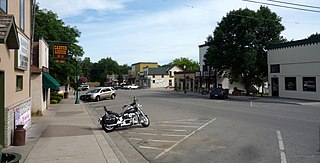
Carver is a city in Carver County, Minnesota, United States. The population was 3,724 at the 2010 census. The Metropolitan Council has determined the population as of July 1, 2018 is 4,960.

Faribault is a city in Rice County, Minnesota, United States. It is the county seat. The population was 23,352 at the 2010 census. Faribault is approximately 50 miles (80 km) south of Minneapolis and St. Paul.

Forestville is a ghost town in section 13 of Forestville Township in Fillmore County, Minnesota, United States. The nearest communities are Wykoff, to the northwest, and Preston, to the northeast.

Endion station is a former train station in Duluth, Minnesota, United States. It was built in 1899 to serve the Endion neighborhood but was relocated to Canal Park in 1986 to make way for expansion of Interstate 35. Passenger service through the station had ceased in 1961 and freight service in 1978.

B'nai Abraham Synagogue is a former synagogue in Virginia, Minnesota, United States. It was constructed in 1909 as the first purpose-built synagogue on the Iron Range. It served as the heart of the local Jewish community in the early 20th century. The building was listed on the National Register of Historic Places in 1980 for its local significance in the themes of religion and social history. It was nominated for attesting both to the ethnic diversity of the Iron Range and to the commonality of its immigrant groups maintaining cohesion around religious centers.
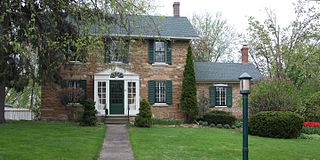
The Frederick Spangenberg House is a historic house in Saint Paul, Minnesota, United States. It was built from 1864 to 1867 as the residence of a farm in what was then rural land outside the urban center. The house was listed on the National Register of Historic Places in 1976 for having local significance in the theme of architecture. Now enveloped by a 20th-century residential neighborhood, it was nominated for being one of the oldest limestone farmhouses preserved in Saint Paul.
Historic preservation in New York is activity undertaken to conserve forests, buildings, ships, sacred Indian burial grounds, water purity and other objects of cultural importance in New York in ways that allow them to communicate meaningfully about past practices, events, and people. Governmental programs for historic preservation range from Federal ownership and active operation of sites to grants and subsidies provided by state government, municipal support of museums and interpretative displays. Nonprofit programs include activities of statewide and local historical associations and museums, and activities of historical societies and museums at the national level. Quasi-governmental organizations, such as the New York State Thruway Authority and Thousand Islands Bridge Authority, play a role as well. Private endeavors, such as investment and other choices made by private landowners to conserve historical features of their properties, are significant but less visible and include groups such as the Historic Districts Council, The New York Landmarks Conservancy and the Preservation League of New York State. During the reconstruction of the World Trade Center site in July 2010, a team of archaeologists discovered a 32-foot-long boat. The craft was at least 200 years old, dating from a time when the Hudson River was partly filled with trash and debris because of a rapidly expanding lower Manhattan.

The Milwaukee Avenue Historic District is a historic district in the Seward neighborhood of Minneapolis. The district comprises two city blocks of small homes on quarter-sized lots. These houses were built between 1884 and 1890 by William Ragan, a Minneapolis real estate speculator. Built for lower-income residents, the houses had deteriorated in condition by the end of World War II, and by the 1970s, were planned for demolition. A group of residents and concerned citizens fought to save the houses, eventually leading to their inclusion on the National Register of Historic Places and the federal protection and rehabilitation that comes with the designation. Today, the houses sit along a bike- and pedestrian-friendly mall on which motor traffic is prohibited.

The Wendelin Grimm Farmstead is a historic farm near Victoria, Minnesota, United States, listed on the National Register of Historic Places. The farm is located within the boundaries of Carver Park Reserve.
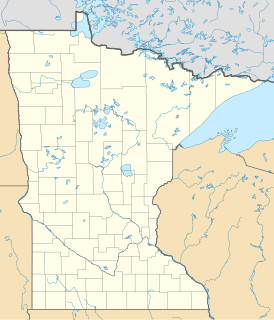
The Andrew Peterson Farmstead is a farm just east of Waconia, Minnesota, United States. The farm is located in rural Carver County, Minnesota on Minnesota State Highway 5. The farm is listed on the National Register of Historic Places for its association with its first owner, Andrew Peterson. It is owned and operated by the Carver County Historical Society.

The Comstock House is a historic house museum in Moorhead, Minnesota, United States. It was built for Solomon Comstock and his family from 1882 to 1883 in a mix of Queen Anne and Eastlake style. Comstock (1842–1933) was one of Moorhead's first settlers and an influential figure in business, politics, civics, and education in the growing city and state.

The Bemidji Carnegie Library is a former library building in Bemidji, Minnesota, United States. It was built as a Carnegie library in 1909 and housed the city's public library until 1961. It was listed on the National Register of Historic Places in 1980 for its local significance in the themes of architecture and education. It was nominated for being a well-preserved example of a Carnegie library and of public Neoclassical architecture.

Terrace is an unincorporated community in Chippewa Falls Township, Pope County, Minnesota, United States. The community was settled in the 1870s around the Terrace Mill. In 1982 a historic district of early buildings and structures was listed on the National Register of Historic Places as the Terrace Historic District for having local significance under the themes of exploration/settlement and industry. It was nominated as a well-preserved example of the small communities that grew up around Minnesota's rural mills in the latter 19th century.

The K. J. Taralseth Company was a prominent retail business in Warren, Minnesota, United States, in operation 1888–1959. The original building it occupied burned down in 1910, so the owners commissioned a new building the following year which is still standing. Both facilities contained the department store as well as space for other tenants—including a Masonic temple—and hosted numerous community events. The 1911 building in which the K. J. Taralseth Company was housed for almost half a century was listed on the National Register of Historic Places in 2002 for having local significance in the theme of commerce. It was nominated for representing a business and a venue that served a central role in the life of the community.
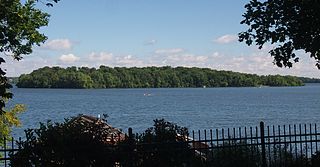
Coney Island of the West is an island in Lake Waconia in the U.S. state of Minnesota that was developed into a summer resort with its heyday from the 1880s to the 1920s. It continued operating up to 1960. The 31-acre (13 ha) island is part of Waconia Township just .5 miles (0.80 km) off the shore from the city of Waconia. It was listed on the National Register of Historic Places in 1976 for its local significance in the themes of commerce and entertainment/recreation. The island site, with its ruins of hotels, cottages, and parks, was nominated for being one of Minnesota's most popular early resorts, and an early expression of the trend of urban dwellers journeying to Minnesota's lakes and parks for recreation. Lambert Naegele, Reinhold Zeglin, and Emile Amblard developed resort buildings and attractions on the island. The best preserved building from this era, however, is the Emile Amblard Guest House on the mainland.

The Jefferson Grain Warehouse is a historic warehouse in Jefferson Township, Minnesota, United States, built in 1868 on the bank of the Mississippi River. The warehouse was listed on the National Register of Historic Places in 1994 for having local significance in the themes of commerce and transportation. It was nominated for being a rare surviving reminder of a brief period when wheat was becoming the most important agricultural crop of the Upper Midwest yet steamboats were still the leading form of transportation.

The Daniel Dayton House, also known as Ravine House, is a historic stagecoach inn in Harmony Township, Minnesota, United States. It was built in 1857 as an overnight stop on the Dubuque–St. Paul Stage Road, a frontier mail and stagecoach route through Iowa and Minnesota. The house was listed on the National Register of Historic Places in 1977 for its local significance in the themes of architecture, exploration/settlement, and transportation. It was nominated for being one of Minnesota's few surviving stagecoach inns, for its stone architecture, and for its association with the pioneer era of Harmony Township.

The Shaw–Hammons House, also known as the DeGraff–Follrath House, is the oldest standing residential building in Anoka, Minnesota, United States. It was originally built around 1852 and then expanded in 1870. The Shaw–Hammons House was listed on the National Register of Historic Places in 1979 for its local significance in the themes of architecture and exploration/settlement. It was nominated for its association with local Euro-American settlement through its succession of notable early owners, and for being Anoka's best-preserved example of Greek Revival architecture.
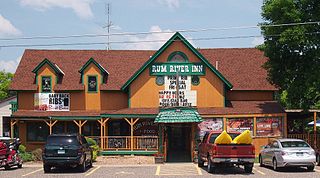
The Riverside Hotel is a historic former hotel in St. Francis, Minnesota, United States. It was originally built around 1860 as a residence, then expanded into a hotel beginning in 1891. This period spanned the heyday of the local lumber industry that urbanized present-day Anoka County, Minnesota. The property was listed on the National Register of Historic Places in 1979 for its local significance in the theme of commerce. It was nominated for being the only surviving commercial building dating to St. Francis's settlement as a lumber boomtown, and its association with the Woodbury family that helped found St. Francis and Anoka, Minnesota.





















